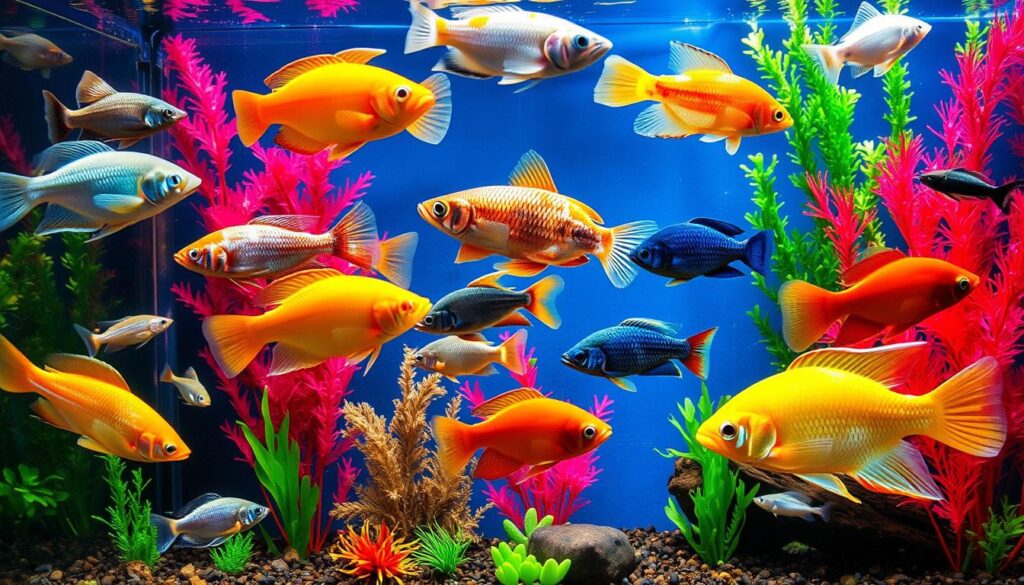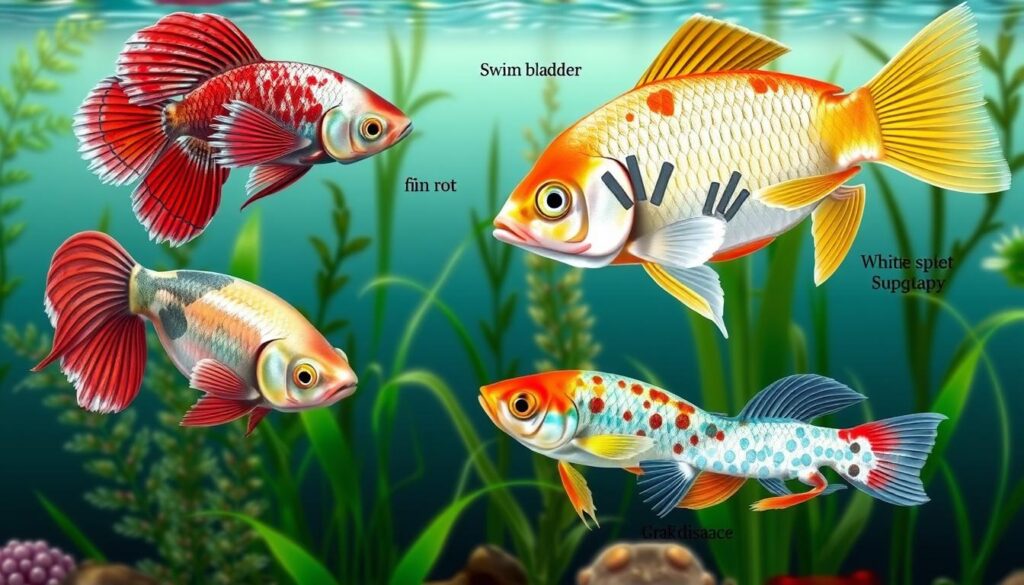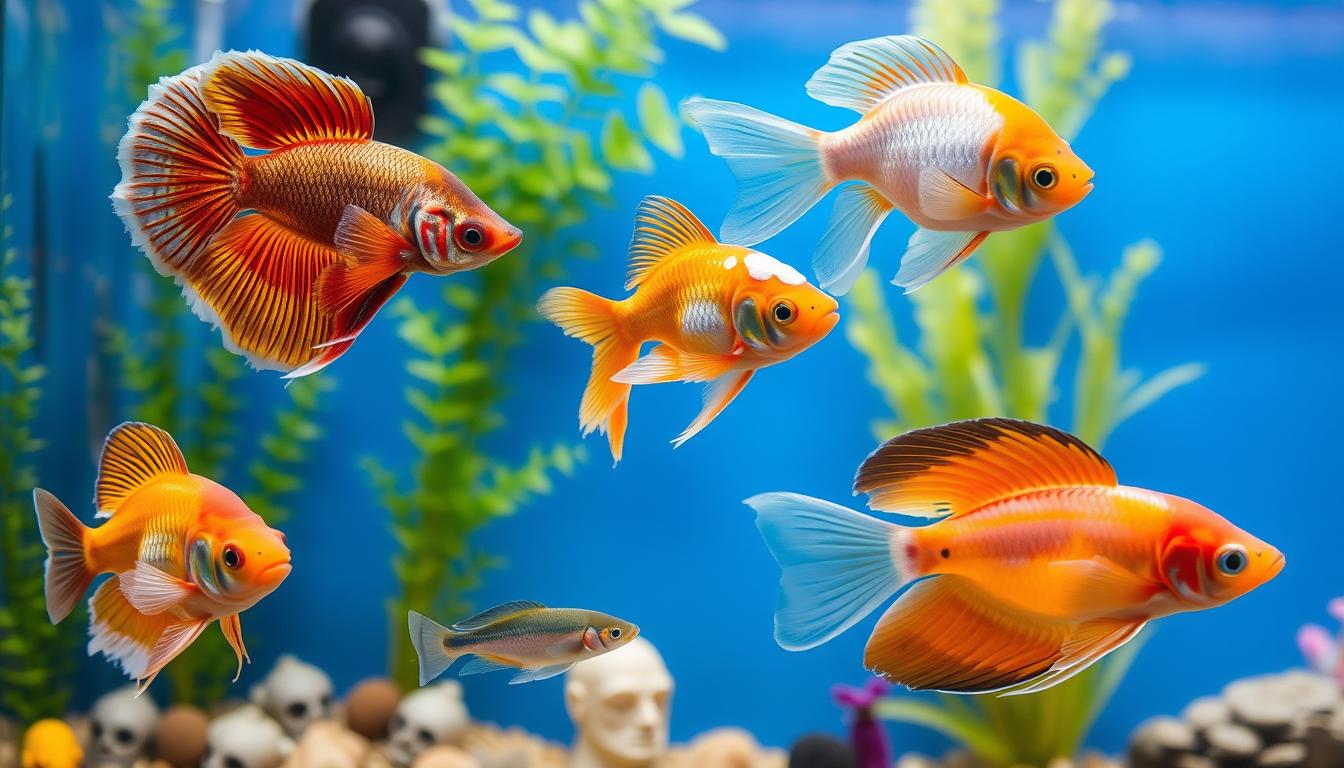Common aquarium fish diseases can harm your aquatic pets’ health. It’s important to spot and treat them early. These diseases can come from bad water, stress, or parasites. Knowing the signs helps you keep your fish healthy and happy.
For more info on fish illness, staying informed is key. Watch your fish closely to catch problems early.
Introduction to Aquarium Fish Health
Diseases in aquarium fish can stem from bacteria, fungi, or parasites. Knowing the causes and signs helps you prevent and treat them. This keeps your aquarium a healthy home for your fish.
Key Takeaways
- Early detection is key to treating common aquarium fish diseases
- Regular monitoring of fish behavior and physical condition is essential
- Poor water quality can contribute to fish illness
- Stress can weaken a fish’s immune system, making it more susceptible to disease
- Proper treatment and prevention can help maintain a healthy aquarium ecosystem
Understanding Aquarium Fish Health Basics
Aquarium fish health is complex, but knowing the basics is key. A healthy fish looks vibrant, has erect fins, and is active. Watching your fish closely helps spot illness signs early, so you can act fast.
Look for normal behavior like swimming and eating. If your fish seems tired, breathes hard, or doesn’t want to eat, it might be sick. Regular checks help catch problems before they get worse.
Signs of a Healthy Fish
- Active and alert behavior
- Vibrant color and healthy scales
- Erect fins and proper swimming posture
Normal vs Abnormal Behavior
It’s important to know what’s normal and what’s not in your fish’s behavior. Normal is swimming, eating, and playing with others. But if your fish hides a lot, seems tired, or breathes fast, it might be sick.
The Importance of Regular Health Monitoring
Keeping an eye on your fish’s health is vital. By watching them often, you can spot sickness early. This lets you treat it quickly and stop diseases from spreading.
The Role of Water Quality in Fish Health
Water quality is key to keeping aquarium fish healthy. Bad water can stress fish and make them sick. To avoid this, it’s important to keep water parameters like temperature and pH levels right.
Changing water regularly and using good filters are crucial. Aim to change 10-15% of the water each week. Also, use a water testing kit to spot problems early. For more tips, check out petsrelax.com on keeping your aquarium healthy.
Here are some important water quality factors to remember:
- Temperature: between 72-82°F (22-28°C)
- pH: between 6.5-8.5
- Ammonia: 0 ppm
- Nitrite: 0 ppm
- Nitrate: below 20 ppm
By keeping these water quality tips in mind, you can prevent aquarium sickness. This will help your fish stay healthy and happy.
Common Aquarium Fish Diseases and Their Symptoms
Aquarium fish can get sick, and knowing the signs is key to treating them. Tropical fish diseases and freshwater fish diseases fall into several categories. These include bacterial, fungal, parasitic, and viral infections.
It’s important to understand the differences in diseases between tropical and freshwater fish. Tropical fish are more likely to get sick because of their warm water.
Bacterial Infections
Bacterial infections are common in aquarium fish. They can happen due to bad water quality or injuries. Signs include hard breathing, being very tired, and visible wounds or sores.
Fungal Diseases
Fungal diseases, like cotton mouth or mouth fungus, can also occur. They are often caused by poor water quality or stress. You’ll see white, cotton-like growths on the fish’s mouth or body.

Parasitic Infections
Parasitic infections, such as ich or velvet disease, can spread if infected fish or plants are introduced. Look for white spots or a dusty look on the fish’s body.
Viral Conditions
Viral conditions, like lymphocystis or viral hemorrhagic septicemia, can also affect fish. They are often caused by bad water quality or stress. Symptoms include being very tired, hard breathing, and visible lesions or wounds.
Keeping an eye on water quality and fish behavior is crucial. By spotting symptoms early and treating them right, you can keep your fish healthy and happy.
White Spot Disease (Ich): Prevention and Treatment
White Spot Disease, also known as Ich, is a common problem in aquariums. It’s caused by a parasite that harms the fish’s skin and gills. This leads to breathing issues and other health problems. Keeping the water clean and at the right temperature is key to stopping Ich.
To stop Ich, it’s important to follow some steps. These include proper quarantine procedures for new fish and regular water changes. Also, watch the water quality closely. Keeping the fish stress-free by providing hiding spots and not overcrowding helps too.
When treating Ich, medications like malachite green or formalin can work. But, it’s vital to use the right amount and follow the treatment time. This helps avoid harming the fish. Also, be ready for side effects like breathing trouble or skin issues.
- Quarantine new fish for at least 2 weeks before introducing them to the main tank
- Perform regular water changes (at least 10% every week)
- Monitor water quality parameters, such as ammonia, nitrite, and nitrate levels
- Avoid overcrowding and provide plenty of hiding places for fish
By following these tips and being proactive, you can keep your fish healthy. This reduces the chance of common fish infections like Ich.
Fin Rot and Body Rot: Causes and Solutions
Fin rot and body rot are common bacterial infections in aquarium fish. They often happen due to poor water quality or injury. These issues can be spotted by decay on the fish’s fins or body. Finding the right treatment is key.
Knowing the type of rot is important for the right treatment. Fin rot can be mild, moderate, or severe. Body rot may show as cotton-like growths or open sores. This helps choose the best treatment.
Identifying Different Types of Rot
Signs of fin rot and body rot include discolored fins, labored breathing, and lethargy. Watching the fish closely is crucial. This helps spot any changes that might mean rot is present.
Treatment Options
Treating fin rot and body rot usually means using antibiotics and improving the environment. Some good treatments include:
- Keeping water quality high with regular changes and the right water parameters
- Using antibiotics made for aquarium fish
- Feeding a balanced diet and making sure the fish gets enough nutrients
By trying these treatments and being proactive, aquarium owners can help their fish get better and stay healthy.
Swim Bladder Disorders: Diagnosis and Care
Marine fish diseases, like swim bladder disorders, can harm the health of aquarium fish. The swim bladder helps fish stay afloat. Problems with it can cause fish to swim poorly, float wrong-side up, or even die.
Causes of swim bladder issues include overfeeding, constipation, and injury. Prevention is key. Owners can prevent these problems by feeding right, keeping water clean, and not overcrowding. When issues arise, finding and treating them can be tough but possible.
Treatment for swim bladder issues might include changing what and how much fish eat. Sometimes, medicine is needed to manage symptoms. Owners should get help from a vet or experienced aquarist to find the right treatment.

- Difficulty swimming or staying afloat
- Floating sideways or upside down
- Lethargy or loss of appetite
- Visible signs of physical trauma or injury
Recognizing these signs and getting treatment quickly can help prevent worse problems. It also boosts the chances of a fish recovering well.
Dropsy and Internal Infections
Dropsy is a sign of serious bacterial infections in fish. It’s key to spot early signs for timely treatment. Look out for swelling, scales that look like pinecones, and changes in behavior.
Spotting issues early is vital. Regular monitoring of your fish’s health can catch problems early. If you see odd symptoms, act fast to stop the infection from getting worse.
Early Warning Signs
- Swelling of the body
- Pinecone-like scales
- Changes in behavior, such as lethargy or loss of appetite
Treating dropsy and internal infections often means using antibiotics. It’s important to follow the treatment plan and finish it. Keeping your fish stress-free while they recover is also crucial.
Knowing the early signs and acting quickly can help your fish get better. This way, you can prevent other diseases from spreading in your aquarium.
Velvet Disease: Recognition and Management
Velvet disease is a parasitic infection that can spread fast in an aquarium. It causes a fish illness that’s hard to treat. You’ll see a golden or rust-colored dust on affected fish, along with rapid breathing and flashing.
To spot velvet disease, watch your fish for any changes. This includes behavior or appearance changes.
The Velvet parasite goes through several stages. The infective stage is when it attaches to the fish’s skin and gills. This causes damage and fish illness symptoms. Knowing the parasite’s lifecycle is key to managing and treating it.
Some important steps to manage velvet disease include:
- Quarantine procedures to prevent the spread of the disease
- Medication options, such as copper-based treatments
- Environmental adjustments, such as improving water quality and reducing stress
Early detection and quick treatment are vital. They help stop the disease from spreading and aid in the recovery of sick fish. By being proactive, you can keep your aquarium healthy. This reduces the risk of fish illness and creates a better environment for your fish.
Essential Medications and Treatments
Having the right medications and treatments is key when treating aquarium fish diseases. The type of disease, its severity, and the fish species all play a role. It’s important to know about antibiotics, natural remedies, and other treatments.
Antibiotics are good for bacterial infections. Natural remedies like salt baths and herbal preparations can also help. Always use these treatments with the advice of a fish expert or vet.
Here are some key things to consider when choosing treatments:
- Accurate diagnosis: You must know the disease before starting treatment.
- Disease severity: The disease’s severity affects the treatment choice.
- Fish species: Different fish need different treatments, so consider your fish’s needs.
It’s also important to know the side effects of treatments. By choosing treatments wisely, you can keep your fish healthy and happy.
| Treatment Type | Description | Common Uses |
|---|---|---|
| Antibiotics | Effective against bacterial infections | Bacterial diseases, such as fin rot and body rot |
| Natural Remedies | Alternative treatments, such as salt baths and herbal preparations | Certain diseases, such as fungal infections and parasites |
Quarantine Procedures and Best Practices
When you add new fish to your aquarium, think about fish health problems that might happen. Quarantine is key to stop diseases from spreading. An effective quarantine tank keeps your fish healthy.
A quarantine tank is a separate space for new fish before they join the main tank. It lets you watch for any sickness. Usually, you keep them there for 2-4 weeks, checking them every day.
Here are some tips for quarantine:
- Use a separate tank with its own filter.
- Keep an eye on water quality and adjust as needed.
- Make sure the tank is calm with lots of hiding spots and plants.
- Watch the fish daily for any signs of illness.
By following these steps and quarantining new fish, you can avoid fish health problems. This keeps your aquarium happy and healthy.
| Quarantine Tank Size | Recommended Duration | Water Quality Monitoring |
|---|---|---|
| 10-20 gallons | 2-4 weeks | Daily |
Preventing Disease Outbreaks in Community Tanks
To keep your community tank healthy, it’s key to have a regular maintenance plan. This means doing water changes, cleaning filters, and vacuuming the substrate. These steps help remove waste and keep your fish disease-free.
Feeding your fish right is also important. Too much food can make the water dirty, which is bad for your fish. For tips on feeding and keeping your tank clean, check out reliable pet care websites.
Maintenance Routines
- Regular water changes (10-15% every week)
- Filter cleaning and replacement as recommended by the manufacturer
- Substrate vacuuming to remove debris and excess food
Keeping your fish stress-free is also crucial. This means giving them places to hide, not overloading the tank, and making sure they get along. Stress reduction techniques help your fish live happily together.
Stress Reduction Techniques
By sticking to these tips and keeping your tank balanced, you can lower the chance of sickness. This way, your community tank will be a happy and healthy place for your fish.
Emergency Response Protocol for Sick Fish
When dealing with common fish infections, quick action is key. This helps stop the disease from spreading to other fish. First, check the sick fish for signs like labored breathing, lethargy, or visible injuries.
Having an emergency kit ready is important. It should have the medicines and tools needed for sudden health problems. For more tips on saving a sick fish, check out this resource.
Some must-haves for your emergency kit are:
- Medications for bacterial and fungal infections
- A quarantine tank for isolating sick fish
- Water test kits to monitor water quality
- A fish net for safe handling and transport

Being prepared and having a plan helps keep your fish healthy. It prevents common fish infections from spreading.
When to Seek Professional Help
Aquarium owners often face fish health problems that can be tough to solve. While many issues can be fixed with the right care, some need a pro’s help. Knowing when to call a fish vet or aquatic specialist is key.
Some signs you might need a vet include persistent or severe fish health problems. This includes unexplained behavior changes, unusual physical signs, or a sudden spike in fish deaths. A fish vet can offer valuable advice and help.
Finding a Fish Veterinarian
To find a fish vet, start by asking local pet stores, online forums, or other aquarium fans. You can also look for certified aquatic vets through groups like the American Association of Fish Veterinarians.
When picking a vet, look at their experience with fish health problems. A good vet will give a detailed diagnosis, suggest treatments, and offer care tips.
Preparing for a Consultation
To get the most from a vet visit, document your fish’s symptoms, water conditions, and any treatments tried. This info helps the vet diagnose and suggest the best care. Getting professional help when needed ensures your fish gets the best care and avoids future health issues.
| Common Fish Health Problems | Causes | Symptoms |
|---|---|---|
| Bacterial Infections | Poor water quality, stress | Labored breathing, lethargy, visible lesions |
| Parasitic Infections | Contaminated food, poor hygiene | Visible parasites, rapid breathing, erratic behavior |
| Viral Conditions | Contaminated water, stress | Labored breathing, lethargy, visible lesions |
Conclusion: Maintaining a Healthy Aquarium Environment
Understanding and managing common aquarium fish diseases is key to a thriving aquarium. Regularly check fish behavior and water quality. Act fast if you see any signs of illness.
Good nutrition, less stress, and a clean, stable home are vital for your fish’s health. Knowing the symptoms and treatments for different diseases helps you act quickly. This gives your fish a better chance to get better.
Prevention is better than cure. Keep learning about fish health and use what you know to keep your aquarium safe and lively. With care and attention, you can have many happy years with your aquarium.
FAQ
What are the most common aquarium fish diseases?
Common diseases in aquarium fish include bacterial, fungal, parasitic, and viral infections. These can affect both freshwater and marine fish. Symptoms include discoloration, abnormal behavior, and physical lesions.
How can I recognize the signs of a healthy fish?
Healthy fish show bright colors, active swimming, and normal behavior. Look for clear eyes, undamaged fins, and a streamlined body.
Why is water quality so important for fish health?
Good water quality is key for fish health. It means keeping the right temperature, pH, and levels of ammonia, nitrite, and nitrate. Poor water quality can stress fish and make them sick.
What are the most common symptoms of bacterial infections in aquarium fish?
Bacterial infections can cause cloudy eyes, fin and skin lesions, and odd swimming. Common diseases include columnaris, fin rot, and body slime infections.
How can I treat white spot disease (Ich) in my aquarium?
To treat Ich, raise the water temperature, add aquarium salt, and use the right medication. Keeping the water clean and quarantining fish are also key.
What are the signs and treatment options for fin rot and body rot in aquarium fish?
Fin rot and body rot are bacterial infections. They cause frayed, discolored, or eroded fins and open sores. Treat by improving water quality, using antibiotics, and supporting the fish’s immune system.
How can I diagnose and care for a fish with swim bladder disorder?
Swim bladder disorders affect buoyancy and swimming. They’re often caused by constipation, overfeeding, or trauma. Symptoms include floating sideways or upside down. Treatment may include diet changes, water changes, and medication.
What are the early warning signs of dropsy and internal infections in aquarium fish?
Dropsy symptoms include pinecone-like scales, swelling, and lethargy. Internal infections cause behavioral changes and loss of appetite. Quick treatment with antibiotics is vital.
How can I recognize and manage Velvet disease in my aquarium?
Velvet disease is a contagious parasitic infection. It makes fish skin and fins shimmer with a golden or rust color. Treat by quarantining, using medication, and improving water quality.
What are the key considerations for using antibiotics and other medications in my aquarium?
Use antibiotics and medications carefully. Accurate diagnosis and following dosage instructions are crucial. Consider potential side effects and natural remedies like salt baths.
Why is quarantine so important for new fish additions?
Quarantining new fish prevents disease spread. It lets you check for illness and treat without risking your tank’s health.
How can I prevent disease outbreaks in my community aquarium?
Prevent disease by keeping a routine of water changes, filter cleaning, and diet. Provide hiding spots and a balanced diet to boost fish immunity.
When should I seek professional help for a sick fish?
If treatments don’t work or if the illness is severe, seek a fish vet or aquatic specialist. They can diagnose and recommend treatment.

